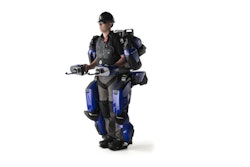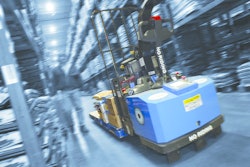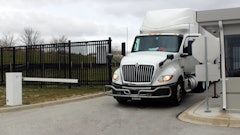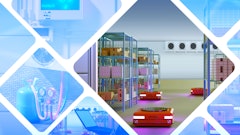
When you think of robotics, what comes to mind? A humanoid along the lines of Rosie the Robot Maid from the Jetsons or a host from Westworld? Maybe something more grounded in the realities of food distribution operations, like an articulated arm used for palletizing or an autonomous mobile robot moving product from point A to point B.
While Rosie the Robot will likely remain fiction for the foreseeable future, the confluence of advanced technology and application expertise is providing new solutions to old problems. Today’s logistics robotics market is evolving faster than ever, producing a broader array of solutions that are more capable than ever before.
Today’s robotics innovations are a result of key advances in technology, like vision systems and advanced gripping mechanisms, all coming together for maximum effect. But before becoming fixated on the gripping technology used to physically manipulate objects, look closely at the intelligence and perception responsible for putting such tools to use. Simply put, think about the robot’s “brains.”
Log in to view the full article
When you think of robotics, what comes to mind? A humanoid along the lines of Rosie the Robot Maid from the Jetsons or a host from Westworld? Maybe something more grounded in the realities of food distribution operations, like an articulated arm used for palletizing or an autonomous mobile robot moving product from point A to point B.
While Rosie the Robot will likely remain fiction for the foreseeable future, the confluence of advanced technology and application expertise is providing new solutions to old problems. Today’s logistics robotics market is evolving faster than ever, producing a broader array of solutions that are more capable than ever before.
It’s What’s on the Inside That Counts
Today’s robotics innovations are a result of key advances in technology, like vision systems and advanced gripping mechanisms, all coming together for maximum effect. But before becoming fixated on the gripping technology used to physically manipulate objects, look closely at the intelligence and perception responsible for putting such tools to use. Simply put, think about the robot’s “brains.”
What makes up those brains? A combination of sensors, data science and machine learning—the package that enables the robot to make the best use of available tools when executing a task.
To understand the importance of the robot’s intelligence, think about a common, rigid gripping tool—a pair of chopsticks. Humans can use these instruments to pick up and move food without much trouble because they know what chopsticks are, how to effectively perceive all sorts of sushi and can manipulate their fingers to control the chopsticks—usually well enough—to pick up the pieces and eat them. This is where robots struggle. Why is that? The answers go much deeper than their inability to appreciate sushi.
Humans have the most advanced perception, cognition and motion-planning systems in the known world. These are what make general tasks like washing dishes, eating and brushing teeth seem so effortless. Robots, on the other hand, lack the perception, cognition and motion-planning abilities to generalize beyond a specific use. We can design a vision system to find a piece of sushi, we can even design motion-planning algorithms to enable a robot to pick up the sushi, but change the sushi to a maki dish and the vision system fails. Likewise, change the length of the chopsticks and the motion planners will struggle. Manipulating those chopsticks with the necessary level of precision to put them to good use across a broad set of applications requires more “thought.”
Teaching Robots to Think
Advances in perception and processing power are enabling robotics to more precisely manipulate gripping tools. Data science and machine learning are pushing the capabilities of robotics systems forward, getting closer to answering the question of where exactly to position the tips of those chopsticks for all those sushi variants and chopstick sizes.
It’s all about the data. To enable robotics to properly perceive environments with such variations, lots of data is required. Take the sushi example, where computer vision algorithms can be designed to find the characteristics of a given piece, like a spicy tuna roll. But if we introduce a California roll, the algorithm fails. Vision engineers can come in and update the algorithm to identify the California roll—but then the introduction of another variant requires another development cycle for the robotics to perform. However, by using a data-driven machine learning approach, the data from a wide variety of sushi is used to train a machine learning model. In practice, when a new variety of sushi is introduced, there is a strong chance the system will recognize it—even if the robot has not seen it before.
This concept of data-driven machine learning is applied across a wide variety of challenges. Consider an example outside of logistics, such as the security industry. Data scientists are using machine learning algorithms to help cameras identify certain objects as dangerous. The goal is to enable security cameras to handle more complex tasks previously reserved for humans, like recognizing people wearing masks or carrying weapons as potential threats, and then triggering an alarm.
The Right Tools Make the Job Easier
Of course, the principle of choosing the right tool for the job holds true for even the smartest robots, as gripping mechanisms are a key enabler of increased capability. There is a reason the spoon was invented—chopsticks can’t do it all.
Often, advances in tooling can make the perception and cognition job much simpler. Consider soft robotics grippers that use highly compliant materials like those found in living organisms to ease the grasping of certain objects like tomatoes or eggs. In contrast to more rigid robotic tools, soft robotics offer adaptability and flexibility for accomplishing a dynamic array of tasks. Use of this more forgiving gripping technology has the potential to make the vision and sensing requirements less strict, as soft robotics do not require the same level of precision to grasp items.
In practice, soft robotics shine when it comes to more amorphous substances that traditional gripping technology, like a clamp, struggle to handle. For example, corrugate cases and hard plastic totes have the strong structure and defined edges that rigid, mechanical tooling can handle effectively. On the other hand, soft robotics are adept at handling more malleable substances like dough, thanks to flexible characteristics that enable them to adapt to the contents in their grasp.
New Solutions to Longstanding Challenges
As the full spectrum of robotics technology pushes forward, it offers tremendous potential for food distribution operations, chiefly by bringing the benefits of automation to tasks previously reserved for manual labor. Delivering this capability comes not from a single innovation, but from combining several advances such as vision, onboard intelligence, gripping and allied components in a tightly integrated package.
Market forces such as ever-changing packaging types and configurations, SKU proliferation and e-commerce continue to reshape the food logistics landscape. As these changes continue at an ever-increasing pace, robotic systems capable of adapting will enable end users to stay competitive.
Translating Cool Technology to Real-World Results
Everyone from massive conglomerates to the hottest new startups can bring a robot into a facility to perform a specific task. But that alone is no guarantee of success. Finding a solutions provider that pulls together robotics, logistics expertise and a complete solution set is rare. Food distribution operations must consider robotics as part of a holistic view that considers existing systems and overall processes.
Considering this larger view is required to avoid developing an interesting robotic system that misses the mark with overall system requirements. Success starts with clearly outlining the individual automated processes and how these translate into an improved overall performance. For this reason, thinking of integration as simply implementing a single robot is not an option.
Data Connectivity: A Conduit to Greater Functionality
As robotics sets its sights on new tasks to automate, the importance of another critical development comes into focus—connectivity. Tracking the progress of logistics tasks requires leveraging the power of connected devices and software to provide real-time data and make the best use of all available resources to manage processes for overall output.
In this rapidly advancing, connected climate, the data collected takes on increased importance. Having a platform that can handle perception, thinking and execution, and generate the data, is vital. Connecting the producer of the data to multiple systems through a single cloud-based resource for machine learning and modeling can add even more power to an automated system. This learning across multiple types of solutions and machines enhances the performance of all robotics solutions, leading to greater throughput and crucially, fewer manual interventions.
Business Benefits
The innovation extends beyond just the technical solutions themselves. With these new technologies driven by more intelligent approaches, some solutions can be very cost effective. New business models have also been making inroads to the market, such as “robotics-as-a-service,” which involves leasing robotics, rather than purchasing them outright. This model seeks to remove the large, upfront capital expenditures, which are one of the most significant barriers to adopting robotics solutions.
But even the most forgiving financial models require results, and the tight margins of food distribution offer little forgiveness for poorly integrated or otherwise ill-conceived robotics investments. Trade organizations like the Robotic Industries Association can help address these risks, offering certification programs, events and other resources to help end users make sound decisions that minimize risk and produce real results.
Recent advances in robotics have led to some amazing capabilities. These advances are starting to enter the industrial robotics space and end-users can see how these fresh technologies can deliver on the promise of greater output and efficiency.

















